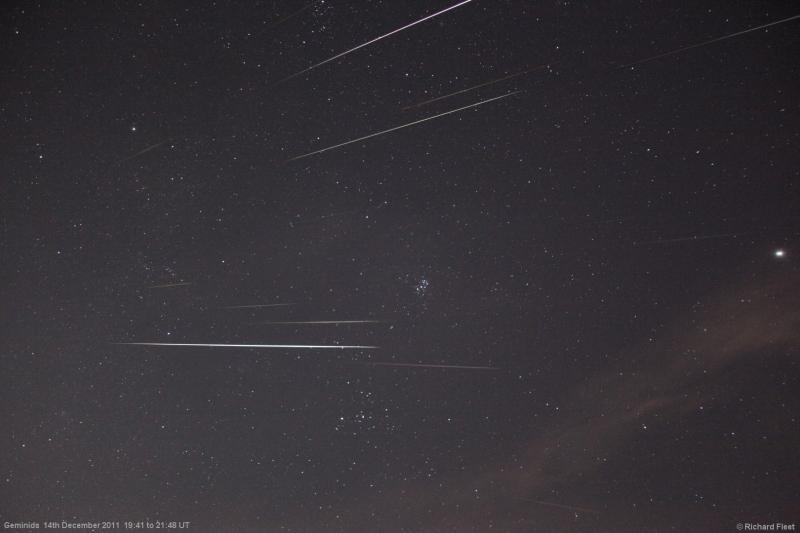2014 December 13
The Geminid Meteor Shower
 |
| Geminid meteors, Richard Fleet, 2011 December |
The Geminid meteor shower is now underway, with peak activity expected on the night of December 13/14.
The Geminids are the richest of the annual meteor showers, with rates outstripping those of the Perseids for a 24-hour interval centred on their 14 December maximum. The peak this year coincides with a last quarter Moon in Virgo, so there should be comparatively little interference by moonlight even during the early morning hours. The highest observed rates are most likely during the night of December 13/14, particularly in the pre-dawn hours of Sunday, December 14, and conveniently during a weekend.
This year, Geminid maximum is expected at around 07h on Sunday, 14th December, when the peak Geminid Zenithal Hourly Rate may reach 120 m/h. There is the added bonus of an increased proportional abundance of bright events after maximum; past observations show that bright Geminids become more numerous some hours after the rates have peaked, a consequence of particle-sorting in the meteor stream.
The Geminid maximum is quite broad so it is important to have a spread of observers making observations throughout the nights of 12th/13th, 13th/14th and on 14th/15th December to ensure adequate coverage of the shower maximum. In addition, observations by BAA members in North America and the Far East will be welcomed by the Meteor Section to improve coverage of the period of peak shower activity.
The Geminid radiant (at RA 07h 32m Dec +33o, just north of Castor) rises early in the evening and reaches a respectable altitude well before midnight, so observers who are unable to stay up late can still contribute useful watches.
Meteor showers are supposed to come from periodic comets, yet there is no very short period comet that matches the orbit of the Geminid meteoroid stream. Instead, the orbit of the Geminids is occupied by an object called 3200 Phaethon, which looks remarkably like a rocky asteroid. A group of astronomers led by David Jewitt of UCLA have been using NASA’s STEREO probes to take a closer look at 3200 Phaethon when it passes closest to the Sun. In 2010 one of the STEREO probes recorded a doubling of Phaethon’s brightness as it approached the Sun, as if sunlight were shining through a cloud of dust around the asteroid.
The observers began to suspect 3200 Phaethon was something new – a “rock comet” which is, essentially, an asteroid that approaches so close to the Sun that solar heating scorches dusty debris right off its rocky surface forming a tail of rocky grains. Seeing 3200 Phaethon sprout a tail, even a small one, provides some confidence that Phaethon is indeed the source of the Geminids – but a mystery remains: How can such a stubby protuberance produce such a grand meteor shower? Only time and further continued observations may provide the answer.
Geminid meteors enter the atmosphere at a relatively slow 35 km/sec, and thanks to their robust (rocky/asteroidal as opposed to dusty/cometary) nature tend to last longer than most in luminous flight. Unlike swift Perseid or Orionid meteors, which last only a few tenths of a second, Geminids may be visible for a second or longer, sometimes appearing to fragment into a train of ‘blobs’. Their relatively low speed and the abundance of bright events makes the Geminids a prime target for imaging.
For further information, or copies of report forms, observing notes, and details of how to carry out group meteor watches, please visit the BAA Meteor Section website at http://britastro.org/meteor.
| The British Astronomical Association supports amateur astronomers around the UK and the rest of the world. Find out more about the BAA or join us. |
